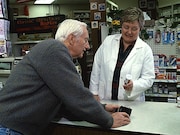Prenatal Opioid Exposure Harms Long-Term Child Development
Negative effects on cognitive, motor outcomes seen from age 6 months persist to school age
Standing Frame Program Can Up Motor Function in Progressive MS
Motor function increased significantly but not to degree considered a priori as clinically meaningful
Health Care Professionals Exhibit Gender Bias
Biases associate men with careers and surgery and women with family and family medicine
Rimegepant Shows Promise for Relief From Migraine Attacks
Increase seen in percentage of patients free from pain, from their most bothersome symptom at two hours
Medicare Drug Rebate Plan Withdrawn by Trump Administration
Rebates would have been paid directly to seniors in Medicare Part D program when they filled their Rx
Negative Cognitive Bias May Be Key to Depression in Active IBD
Emotional recognition bias may partially mediate the link between IBD activity and depression
Capping Work Hours in Residency Does Not Impact Outcomes Later
No differences seen in post-training patient mortality, readmissions, or costs of care
Galcanezumab Can Cut Frequency of Cluster Headache Attacks
Mean reduction in weekly frequency of cluster headache attacks greater with galcanezumab versus placebo
Mentally Stimulating Activities Lower Risk for Cognitive Decline
Activities included reading books, using computers, social or craft activities, and playing games
EHR System-Generated In-Basket Messages Linked to Burnout
Receiving more than average number of messages linked to increased probability of physician burnout



















